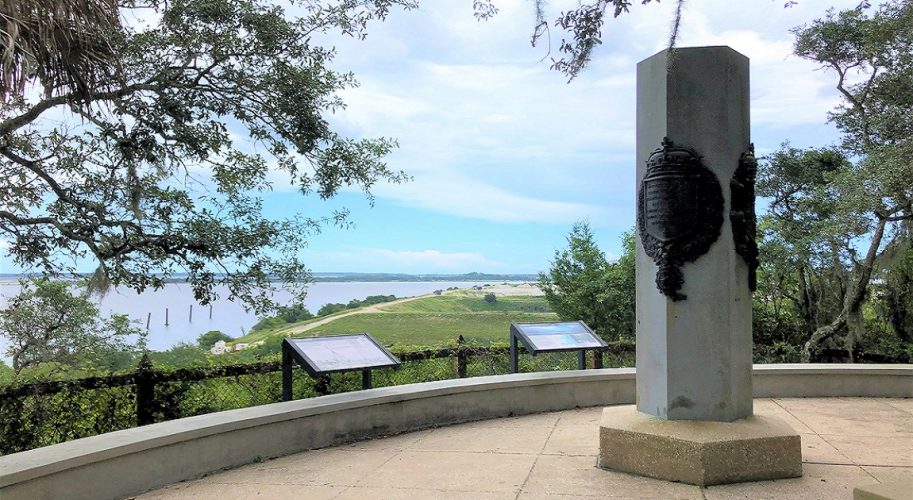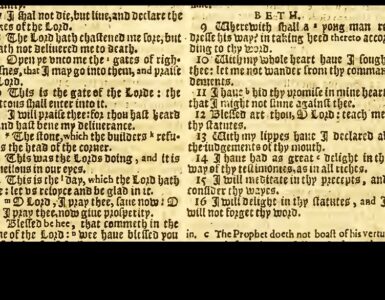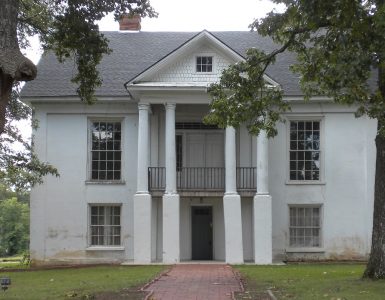Jean Ribaut (or Ribault) was born about 1520 in the Normandy coastal village of Dieppe. He was a Huguenot as was Admiral of France Gaspard de Coligny (1519-1572) who ordered Ribaut to lead an expedition to explore the coast of the New World. Anchors were weighed early in the spring of 1562 with the expedition landing May 1 at the mouth of what is currently the St. John’s River in Florida (Ribaut called it the River of May). He set a column at the site claiming the land for King Charles IX. With the help of the local Timucua people the French learned about the wildlife and vegetation of the area and how to survive in the unfamiliar and challenging environment. Three weeks later the expedition set sail headed north landing at Port Royal where the French Broad River empties into the ocean in South Carolina. This settlement was also claimed for France by setting a column May 22. Some members of the expedition remained at Port Royal to establish a village while Ribaut and the crew sailed home to get supplies July 20, 1562. For protection a defensive structure named Charlesfort was built at the settlement, the location of which has been determined by recent archaeology to be on Parris Island. Ribaut arrived in France to find war taking place between the Huguenots and Roman Catholics, so he found refuge in England. With the Peace of Amboise, March 1563, some liberty of conscience was given the Huguenots, but their worship services were held under some restrictions in France. During Ribaut’s time in England the Charlesfort settlement collapsed with survivors taking to the sea in a small boat from which they were rescued by an English ship.
While Ribaut was in England with some of his time spent in prison, Coligny organized a new expedition in 1564 that included two-hundred individuals led by René de Goulaine de Laudonnière. The expedition arrived at the St. John’s River June 22 and started a settlement named La Caroline that included a fort. As had Charlesfort, the situation soon deteriorated as relations with the Timucua were strained and the settlers were ready to leave because they had not found the natural resources anticipated. Some colonists left while others struggled to survive at La Caroline. It was decided to abandon the settlement in the summer of 1565 but the surprise return of Ribaut in August with troops, supplies, tradesmen, women, and children stabilized the situation. But the fort at La Caroline, Fort Caroline today, and the settlement would not survive as will be seen from the information given about the following locations.
Florida Huguenot Trail
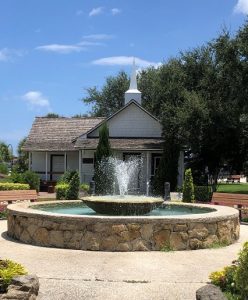 Location 1. North of Daytona Beach is Ormond Beach where there is a monument for the first Christian marriage in North America. The monument is at the intersection of North Beach Street and West Granada Boulevard in Bailey Riverbridge Gardens which is a lovely site on the Halifax River. The Pilgrims Rest Primitive Baptist Church is the oldest building in Ormond Beach with its congregation organized in 1877. You can see the marriage monument in the flower bed to the right of the church in the photograph. The inscription reads as follows:
Location 1. North of Daytona Beach is Ormond Beach where there is a monument for the first Christian marriage in North America. The monument is at the intersection of North Beach Street and West Granada Boulevard in Bailey Riverbridge Gardens which is a lovely site on the Halifax River. The Pilgrims Rest Primitive Baptist Church is the oldest building in Ormond Beach with its congregation organized in 1877. You can see the marriage monument in the flower bed to the right of the church in the photograph. The inscription reads as follows:
Near this site the first Christian Marriage in North America is said to have occurred in 1566 between Ernst D’Erlach a French Huguenot nobleman and Princess Issena of the Timucuan Indian Tribe. Dedicated by the Ernst D’Erlach Chapter the Huguenot Society of Florida May 13, 1978
Was it the first Christian marriage, or the first Protestant marriage given the Spanish presence early in the sixteenth century?
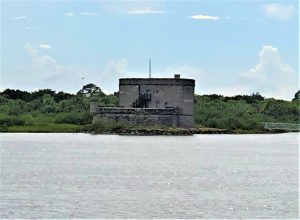 Location 2. The photograph shows Fort Matanzas which was built in 1740 a century after the Huguenots, but the block-house style fort shows the continued importance of the Matanzas Inlet for access to Spanish controlled St. Augustine. Near the site of the fort, French forces were shipwrecked and Spanish troops commanded by Admiral Pedro Menéndez marched south from their massacre of Huguenots at Fort Caroline (see Location 4 below) for engagement resulting in the killing of over 300 Huguenots. The Spanish word “matanzas” means killings or slaughter. At the National Park Service visitors’ center tickets for a pedestrian ferry to the island fort are available but check in advance regarding scheduling. Access to Fort Matanzas is about 35 miles north of Ormond Beach on A1A. The A1A highway runs along the Florida coast providing good views of the Atlantic Ocean and the beaches; it is slower than I-95 but surely more scenic and less travelled.
Location 2. The photograph shows Fort Matanzas which was built in 1740 a century after the Huguenots, but the block-house style fort shows the continued importance of the Matanzas Inlet for access to Spanish controlled St. Augustine. Near the site of the fort, French forces were shipwrecked and Spanish troops commanded by Admiral Pedro Menéndez marched south from their massacre of Huguenots at Fort Caroline (see Location 4 below) for engagement resulting in the killing of over 300 Huguenots. The Spanish word “matanzas” means killings or slaughter. At the National Park Service visitors’ center tickets for a pedestrian ferry to the island fort are available but check in advance regarding scheduling. Access to Fort Matanzas is about 35 miles north of Ormond Beach on A1A. The A1A highway runs along the Florida coast providing good views of the Atlantic Ocean and the beaches; it is slower than I-95 but surely more scenic and less travelled.
Location 3. The Huguenot Cemetery in St. Augustine does not include any Huguenot graves. Its first use was in the nineteenth century and it no longer accepts interments. St. Augustine was established in 1565 by Spain to secure its claim to Florida and provide a base for defense against settlers such as the French Huguenots. Even though the Castillo de San Marcos was not built until the end of the seventeenth century, it could be said the Huguenots’ settlement attempts seeded its eventual construction. The Castillo is worth a visit, and it provides a fine view from atop its walls of Matanzas Bay, St. Augustine Inlet, and the Bridge of Lions.
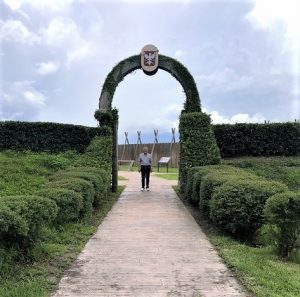 Location 4. With the failure of Charlesfort in South Carolina, Coligny was looking to establish another settlement. A colleague of Ribaut during the first expedition, René de Goulaine de Laudonnière, was chosen to establish the new village. About eight miles west of the Huguenots’ original landing at Mayport on the St. Johns, the new expedition built La Caroline which included a village and Fort Caroline. Once again, things did not go very well as the Huguenots’ relationship with the Timucua broke down and their hopes for financial gain were dashed. Mutiny resulted with some individuals leaving, but then Ribaut returned in August 1865 with supplies, soldiers, and more settlers. Menéndez (see Location 2) attacked La Caroline September 20, 1565 slaughtering about 140 settlers, but women and children were allowed to live with some settlers managing to escape. The National Parks Service tends the Fort Caroline site which includes the reconstructed fort, a visitor center, and Location 5. The site is accessed from Fort Caroline Road.
Location 4. With the failure of Charlesfort in South Carolina, Coligny was looking to establish another settlement. A colleague of Ribaut during the first expedition, René de Goulaine de Laudonnière, was chosen to establish the new village. About eight miles west of the Huguenots’ original landing at Mayport on the St. Johns, the new expedition built La Caroline which included a village and Fort Caroline. Once again, things did not go very well as the Huguenots’ relationship with the Timucua broke down and their hopes for financial gain were dashed. Mutiny resulted with some individuals leaving, but then Ribaut returned in August 1865 with supplies, soldiers, and more settlers. Menéndez (see Location 2) attacked La Caroline September 20, 1565 slaughtering about 140 settlers, but women and children were allowed to live with some settlers managing to escape. The National Parks Service tends the Fort Caroline site which includes the reconstructed fort, a visitor center, and Location 5. The site is accessed from Fort Caroline Road. 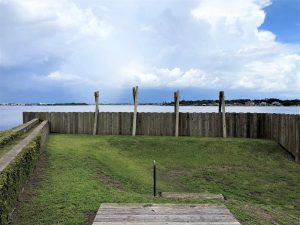
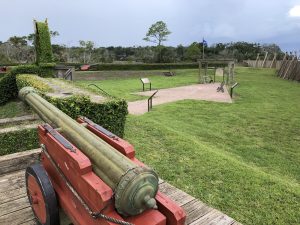
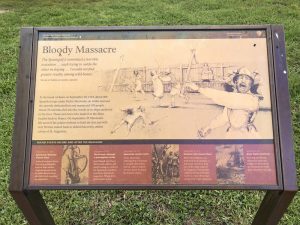
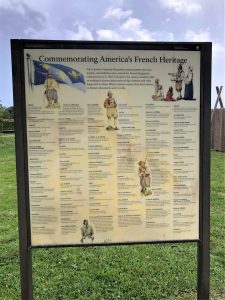
Location 5. Pictured in the header for this post is the St. John’s River looking north from the terrace surrounding the Jean Ribaut Monument. The tall structure with bronze plaques is a reimagination of the column set by Ribaut the day after he landed with his Huguenot expedition, May 1, 1562 (i.e., May 2). It is a short drive from the Fort Caroline Visitor Center.
Location 6. To see the other Huguenot sites, it is necessary to cross the St. John’s River. This could be done by road, but if your family has never ridden a ferry, here is your chance. It is a short ride but an enjoyable experience. The ferry is accessed at Mayport Ferry Landing and the historical marker pictured below is on the landing site. Check in advance for scheduling and rates. Notice that the ferry is named “Jean Ribault.”
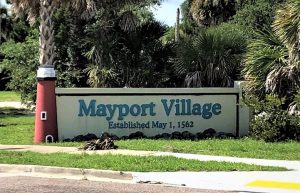
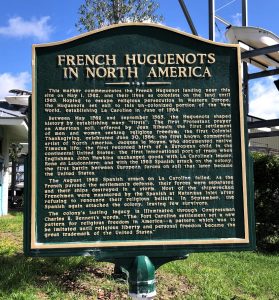
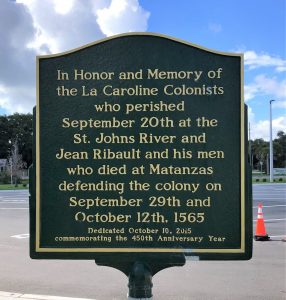
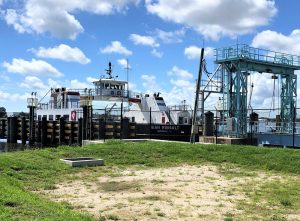
Location 7. If the ferry was taken, you will arrive at Fort George Landing. Turn right coming out of the landing, cross the bridge, and soon on the left next to a white picket fence and an old white double porched house with a widow’s walk on its roof is a historical marker for Jean Ribaut. The Ribaut marker is just past the marker on the right side of the road for “Pilot Town” (side 1) and “Napoleon Bonaparte Broward” (side 2). The Ribaut marker was erected by the DAR in 1936.
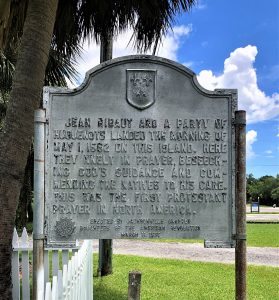
Location 8. Further down the road on the right is a sign marking the access road to Huguenot Memorial Park. The park includes campgrounds and there is access to the dune area. The historical marker below is at the entrance gate to the park which is operated by the City of Jacksonville. The other photograph shows the type of beach in the inlet near the Huguenots’ landing.
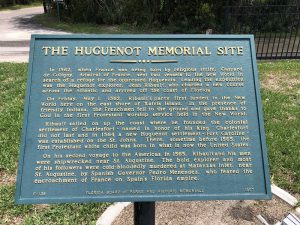
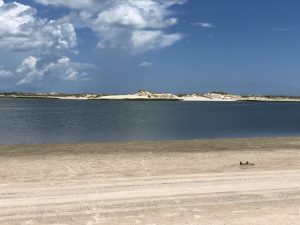
It was not visited but there is a Jean Ribaut High School in Jacksonville. Likewise not visited, was the Ribault Club which is a venue for weddings and social gatherings on Fort George Island. Be advised that during the summer the upper east coast of Florida is subject to afternoon showers that can be torrential, even terrifying for visitors, so if outdoor sites are to be viewed it is advisable to see them as early as possible.
Barry Waugh
Notes—A good source of information regarding historical markers, memorials, and monuments is www.hmdb.org (Historical Marker Data Base). Ribaut’s own account has been published in English in Jean Ribaut: The Whole & True Discouerye of Terra Florida, A Facsimile Reprint of the London Edition of 1563, as edited by Jeannette T. Connor for The Florida State Historical Society, 1927. Connor also wrote the introductory biography of Ribaut in the book which also discusses the English editions. The brief article, “Charlesfort,” on South Carolina Encyclopedia, the archaeological discovery of the fort site was in 1980. Brochures from the National Parks Service for Fort Caroline, Fort Matanzas, and Timucuan, as well as the one for Huguenot Memorial Park by the City of Jacksonville were very helpful.


